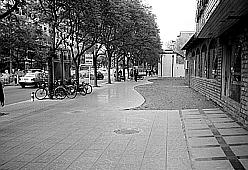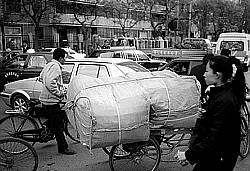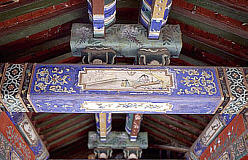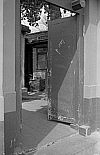| The Voigtländer Bessa-R | |||
|
The Camera Web Links |
|||
|
July 22, 2001: It's been about six months since I plunked down my cash at the camera store in exchange for the Voigtländer Bessa-R and its 35mm f/2.5 pancake lens. Since then many things have happened. Four of my colleagues have been let go at work as part of the global dot-com shelling, and one of them got married. So with cameras in hand – the Bessa-R and a Rolleiflex that I've owned since 1984 – my friend and I headed to the wedding. In Hong Kong, the ceremonies are extremely short. In fact, it was so brief that I never had a chance to sit down. Before the ceremony, something else happened in City Hall. While I was trying to pick up my camera bag, it flipped upside down and dumped the Bessa-R to the floor. Luckily, the floor had rubberlike tiles, and it only fell about 18 inches. I couldn't find any visible marks or damages. In this case, I think the plastic top plate absorbed the impact. At least there isn't a nasty dent – not like the one that I put on a Pentax MX pentaprism when I slipped during a fishing trip in 1979. The other thing that happened is that buying the Bessa-R sparked an interest in expanding my camera collection. I've been busy buying some of the cameras that I couldn't afford when I was younger, as well as many I never knew existed. So my collection has swelled to about 18 or so cameras – up from a couple of Nikons, the Rolleiflex I mentioned above and a Rollei 35S. I used to have a Rollei 35T, but it was lost in Pittsburgh in 1991. If you visit this link (also listed on the left) "Other cameras," you can see some of them. A great book to have in your possession is "Collecting and Using Classic Cameras," by Ivor Mantanle. He also writes for a British weekly magazine that I've discovered recently: Amateur Photographer. I guess this isn't news to those in Britain, as it's been around for decades. Six Months ...In the six months that I've had the Bessa-R, it's proved to be a terrific camera. My initial comments about its portability still hold true. A couple of people have asked about diopter lenses, and it appears that those sold for the Cosina-made Nikon, Olympus and Pentax (and possibly others) SLRs also fit the Bessa-R. I've been shooting primarily Ektachrome 100 slide and TMax 100 black-and-white print film lately. I really prefer Kodachrome, but getting it processed in Hong Kong is really difficult. Sort of back to my roots: slides and black and white. The Bessa-R seems to perform really well with both films. Getting some accessory filters has been another story. The Hong Kong camera stores carry a lot of filters, and as far as I can tell nearly all of them are skylight or polarizer filters. Finding a yellow or red filter in a 43mm thread has proved to be exhausting and frustrating. I guess I'll make do with a polarizer or order it from the U.S. Slides are sharp with plenty of contrast. For those who are reading this for a second time, forget my previous comments about contrast.One of my favorite things about the camera is its weight – or lack of it. Likely, the lack of weight is owing to the use of plastic in place of metal. Ironically, this also brings up one of my concerns: long-term durability. I don't like that you can twist the back with ease, and that smooth rubber covering on the back continues to be marred by tiny scratches. I don't plan on disassembling the camera, but I hope Cosina was careful when selecting materials for the internal mechanics. The neck strap, which I initially referred to as "inexpensive scratchy material," has come to grow on me. It no longer feels scratchy, although I might at some point replace it with one of the Domke Grippers (the narrow version) that I'm using with several other cameras. The camera controls still feel sharp and responsive. The self-timer lever is slightly loose – maybe it's been that way since the start. I've only used it a couple of times. The 35mm lens exhibits some barrel distortion, which you can see in the photo to the left. It's not objectionable, but for certain close-up architectural shots, it's something to keep in mind. The lens' metal focusing ring now has a familiarity to it, although I wish it were a bit looser. It seems that it takes a bit more finger strength than necessary to turn it to and fro. I appreciate the large, bright viewfinder in more than when I first purchased it. The framelines are easy to see, even when there is almost no light. The same goes for the rangefinder patch -- very easy to see and focus in nearly any lighting situation. The LEDs in the display seem too bright these days to the point that they sometimes are a distraction. I'm half tempted to pull the batteries and use a handheld meter. I wish there was a way to turn it on and off on demand without removing the batteries. Camera makers should try a more neutral color like a soft green. The shutter release feels just about right. It's large and rounded, extremely easy to locate, and it requires just the right amount of pressure to trip the shutter. For a rangefinder, it's much noisier than it should be. This is a camera that has no mirror and no motor drive, but it still manages to raise a ruckus. When you're outdoors, it's not as noticeable, but this isn't the camera to bring along when you're trying to shoot unnoticed. I still can't unfold the rewind lever on the first or second try. Sometimes, I don't get it until the fourth or fifth try. The Bessa-R feels like an old friend. It seems like I've had this camera for six years and not six months. Maybe that's the best thing I can say about this camera — or any camera. |
|||




